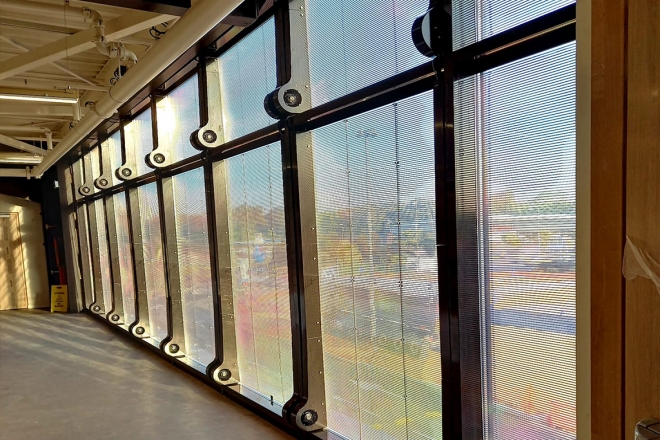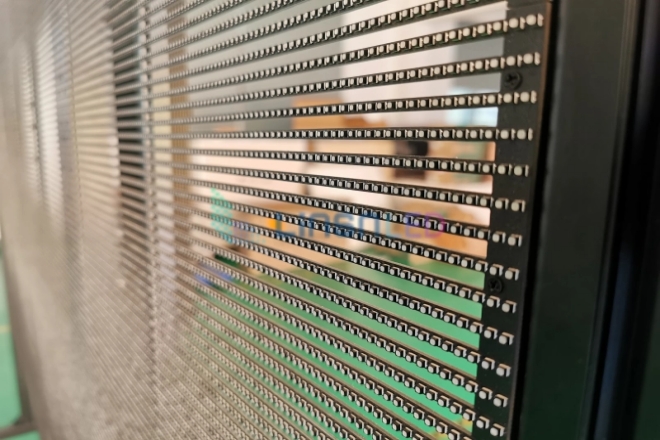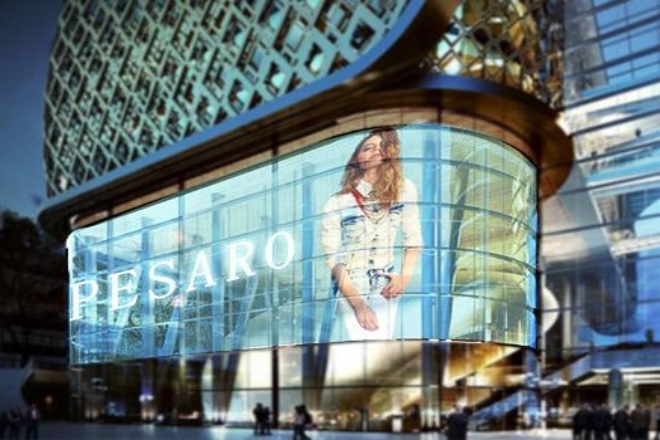介绍
在当今视觉为王的时代,显示技术正以前所未有的速度发展。其中, 透明LED显示屏 凭借独特的透明特性、优异的显示效果,已成为商业显示、户外广告、室内装饰等领域的一颗璀璨新星。
透明LED显示屏不仅能高清呈现图像、视频等内容,还能保留背景视觉的透明度,让观看者在欣赏内容的同时,还能感受到周围环境的美妙融合。
然而面对市场上琳琅满目的透明LED显示屏产品,如何做出明智的选择成为众多用户关注的重点。
本文旨在深入探讨选择透明LED显示屏时应注意的关键因素,帮助读者在复杂的市场中找到最适合自己需求的产品,实现视觉与功能的完美平衡。
1、透明LED显示屏的透明度和视觉效果

1). 透明度
1.1).什么是透明度?
透明就像是一块玻璃,你可以看到玻璃后面的东西。透明LED显示屏也是如此,它可以让观众看到屏幕后面的风景或装饰,同时在屏幕上播放各种图像和视频。
1.2).不同模型透明度不同:
想象一下,你站在两家商店前,两家商店都使用透明 LED 显示屏,但一家看起来更“透明”,另一家则略显模糊。这是因为它们的透明度不同。选择哪一种取决于你想看到多少背景以及你希望屏幕上的内容有多清晰。
1.3). 找到平衡点:
如果太透明,屏幕上的内容可能不够明亮或不够生动;如果不够透明,背景会看不清。所以,在选择时,你应该考虑你是想看到更多的背景,还是让屏幕上的内容更清晰。
2). 视觉效果优化
2.1).透明度对图片的影响:
透明度高时,屏幕上的颜色可能不那么鲜艳,图像可能显得有点暗。就像在阳光下读书一样;文字会显得更亮。
2.2).如何让图片看起来更美观?
更亮的灯光:使用更亮的 LED 灯,就像晚上阅读时打开台灯一样,使画面更明亮。
良好的设计:在设计屏幕时,想方设法使光线更好地照射在屏幕上,减少浪费。
自动调节:智能屏幕会根据外界光线自动调节亮度,白天较亮,晚上较暗。
色彩管理:确保屏幕上的色彩准确,就像给画作上色一样,使画面更加逼真。
防反射:在屏幕上添加防反射涂层,就像眼镜上的防反射膜一样,以减少反射并看得更清晰。
总的来说,在选择透明LED显示屏的时候,先想好自己想要的效果,看看哪款的透明度最合适,然后再通过一些技术手段,让画面更加的漂亮,这样就能得到一个既通透又美观的显示屏了!
3). 解决 透明LED显示屏的像素密度
3.1). 高分辨率的好处
图像更清晰:高分辨率就如同一张高清照片,屏幕上的图像细节丰富,细小到可以清晰看到一根头发丝,使图像看起来更加真实细腻。
文字可读性更强:如果屏幕上有文字,高分辨率可以让文字的边缘非常清晰。即使距离稍远,文字也不会变得模糊或重叠,易于阅读。
提升观看体验:一般来说,高分辨率的屏幕可以让观众的观看更加舒适,就像观看高清画质的电影一样,体验会更好。
3.2). 关于像素密度的一些知识
- 什么是像素密度?
像素密度就好比是屏幕上“点”的密度,点越多,屏幕越细腻,画质越清晰。
- 如何选择正确的像素密度?
这取决于你在哪里使用屏幕,以及观众距离屏幕有多远。例如,如果你在购物中心投放广告,人们可能会走近才能看到它,因此你需要像素密度更高的屏幕,以使图像更清晰。
但如果是在建筑物外面,人可能离得比较远,可以选择稍微低一点的像素密度,也能看得清楚,成本也会低一些。
因此,在选择透明LED显示屏的时候,应该考虑其放置的位置以及观众站多远可以看到它,从而选择最合适的分辨率和像素密度,使屏幕效果达到最佳。
2、透明LED显示屏的亮度与对比度

1). 亮度 要求
- 背景环境对亮度的影响:
想象一下,您想在阳光明媚的日子在户外的透明 LED 显示屏上显示一些信息。
但如果屏幕亮度不够,阳光可能会使屏幕上的内容变得模糊,难以辨认。
因此,透明LED显示屏在背景环境中显示内容时,需要具有足够的亮度,以保证内容清晰可见。
- 高亮度优点:
高亮度就像给屏幕加了一盏“聚光灯”,可以帮助屏幕内容在强光环境下脱颖而出。
即使在阳光直射的环境下,高亮度透明LED显示屏也能保持内容清晰可见,有效抵消背景灯光的影响。这样,观众可以在任何时间、任何地点轻松看到屏幕上的信息。
2). 对比度增强
- 对比的力量:
对比度就好比图片中的“黑与白”,决定了图像最亮部分与最暗部分之间的差异程度。高对比度可以使图像轮廓更加清晰、色彩更加鲜艳,从而增强图像的清晰度和视觉冲击力。
- 呈现更加丰富、生动的画面:
选择高对比度的透明LED显示屏,意味着可以呈现更加色彩鲜艳、生动逼真的画面,无论是鲜艳的色彩、深邃的阴影,还是细腻的纹理,都能完美呈现。
这样的画面不仅能够吸引观众的注意力,还能让他们更加沉浸在所展示的内容中,获得更深的体验。
3、透明LED显示屏的安装方式及适应性
1). 安装方式多样
透明LED显示屏凭借其独特的透明特性以及多样的安装方式,被广泛应用于各种场景。以下是几种常见的安装方式及其优缺点和适用场景:
1.1). 壁挂式安装
优点:安装方便、节省空间、屏风与墙面结合紧密,整体感强。
缺点:对墙体要求较高,墙体需平整、能承受一定的重量。
适用场景:家庭客厅,小店铺, 展览 房间和其他空间有限且墙壁平坦的地方。
1.2). 悬挂式安装
1.3).嵌入式安装
优点:屏风与周围环境融为一体,美观大方,不占用多余的空间。
缺点:安装困难,需要预先设计嵌入的位置和尺寸。
适用场景:建筑玻璃幕墙、橱窗展示、室内装饰等需要高集成度的场所。
1.4). 其他安装方式
地面安装:适用于展览会、商场等需要大型显示屏的场所,屏体通过支架或者固定装置放置于地面。
壁挂安装:屏幕安装于建筑物窗户或玻璃幕墙上,适用于商铺、 酒店以及其他需要引起路人注意的地方。
2). 场地限制及适应性
在选择透明LED显示屏型号和安装方式时,必须充分考虑场地限制和安装条件,以下是一些关键因素:
场地大小与形状:根据场地的大小和形状选择合适的屏体尺寸和安装方式。比如在狭小的空间,壁挂式或嵌入式安装可能更合适;而在空旷的空间,吊装或地面安装能更好地展示效果。
承重能力:确保安装位置能够承受显示屏的重量。特别是对于悬挂和嵌入式安装,需要进行严格的承重计算和安全评估。
光照及温度条件:透明LED显示屏的显示效果受光照及温度影响较大,在选择安装位置时尽量避免阳光直射及剧烈的温度变化,以保证屏体的稳定性及显示效果。
维护与维修:考虑安装位置是否方便后续的维护与维修工作,例如安装在高空的屏体,需要保证有安全的维护通道与维修平台。
4、透明LED显示屏产品质量及可靠性

1). 选择好的供应商
买透明LED显示屏就像选手机一样,要找一个靠谱的“厂家”或者“卖家”,这个“厂家”或者“卖家”一定要比较出名,大家都说好,这样买来的屏质量才有保障。
为什么?因为他们有经验,做的屏好,售后服务完善,所以出了问题可以及时解决。
2). 屏幕一定要好,耐用
- 怎么看屏幕好不好呢?
我们可以看看屏幕的实际显示效果,比如色彩是否鲜艳,清晰度是否高。也可以听听其他用过的人怎么说,他们的评价很重要。有些屏幕还经过了专门的测试,就像手机要经过质检一样,这样的屏幕比较可靠。
- 耐用是什么意思?
耐用性就是指屏幕不容易坏,可以用很久,就好比你买了一辆车,希望它能多开几年,不用大修。
优质的透明LED显示屏也是如此,它能够经受住阳光、风吹、雨淋等各种环境的考验,不容易出现问题。
3).为什么优质的屏幕如此重要?
省钱:质量好的屏幕不易损坏,因此您不需要花钱频繁修理,从长远来看可以节省金钱。
省心:屏幕一直处于良好状态,不用担心它突然“罢工”而影响您的使用或显示效果。
提升效果:优质的屏幕可以呈现出更加清晰、生动的画面,给观众带来更好的视觉体验,让您的展示或广告更具吸引力。
所以在购买透明LED显示屏的时候一定要选择好的供应商和优质耐用的屏幕,这样才能用的放心,省心,还省钱!
结论
综上所述,选择透明LED显示屏是一个综合考虑多种因素的过程。
从透明度与视觉效果的平衡到分辨率与像素密度的精细选择,从亮度与对比度的优化到安装方式与适应性的灵活调整,再到产品质量与可靠性的严格控制,以及对节能、环保、经济效益的长远考虑,每一步都至关重要。
通过本文的讨论,我们希望给读者提供一份详细的购买指南,帮助大家在众多选择中做出明智的决定。
最后,如果你想了解更多关于LED显示屏的信息, 请与我们联系。
